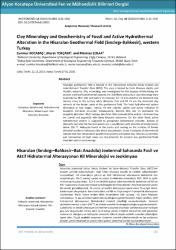Clay Mineralogy and Geochemistry of Fossil and Active Hydrothermal Alteration in the Hisaralan Geothermal Field (Sındırgı-Balıkesir), western Turkey
Künye
Ş, C. K., Tokçaer, M., & Çolak, M. (2016). Afyon Kocatepe Üniversitesi Fen ve Mühendislik Bilimleri Dergisi Clay Mineralogy and Geochemistry of Fossil and Active Hydrothermal Alteration in the Hisaralan Geothermal Field ( S ı nd ı rg ı ‐ Bal ı kesir ), western Turkey Hisaralan ( Sındırgı – Bal ı kesir – Bat ı Anadolu ) Jeotermal Sahas ı nda Fosil ve Aktif Hidrotermal Alterasyonun Kil Mineralojisi ve Jeokimyası, 16, 132–154. http://doi.org/10.5578/fmbd.10852Özet
Hisaralan geothermal field is located at the intersection between Simav Graben and
İzmir–Balıkesir Transfer Zone (IBTZ). The area is hosted by Early Miocene dacitic and
rhyolitic volcanics. Clay mineralogy was investigated for the purpose of identifying the
present and fossil hydrothermalsystems. HS–2 drillhole and surface clay mineralogy were
examined by XRD, SEM and optical microscopy. R2 I–S and smectite are dominant clay
mineral close to the surface while discerete illite and R3 I‐S are the dominant clay
minerals at the deeper parts of the geothermal field. The fossil hydrothermal system
developed at two stages. Initially, Fe–rich chlorite, calcite and pyrite indicative of
propylitic alteration occurred. Subsequently, discrete illite and I‐S postdated the
propylitic alteration. Rb/Sr isotope data from illitic minerals (illite and/or I–S) shows they
are coeval and cogenetic with Early Miocene volcanism. On the other hand, active
hydrothermal system is supposed to precipitate dioctahedral smectite. Activity of
elements indicates the thermal waters are in equilibrium with smectite at temperatures
below 100 °C. Halloysite found in the cracks and coating on the surfaces of former
alteration products indicates a late phase precipitation. O and H isotopes of clay minerals
indicate that low temperature geothermal systems precipitate clay minerals as smectite,
and intersection of fault zones are characteristic for present day geothermal fluids
Hisaralan and ıts surroundings. Hisaralan jeotermal sahası Simav Grabeni ile İzmir–Balıkesir Transfer Zonu (IBTZ)’nin
kesişim yerinde bulunmaktadır. Alan Erken Miyosen dasidik ve riyolitik volkaniklerden
oluşmaktadır. Kil mineralojisi güncel ve fosil hidrotermal alterasyonu belirlemek için
araştırılmıştır. HS–2 sondaj kuyusu ve yüzey örneklerinin mineralojisi XRD, SEM ve optik
mikroskop ile çalışılmıştır. R2 I–S ve simektit yüzeye yakın kesimlerde baskınken saf illit ve
R3 I–S jeotermal alanın derin kesimlerdeki baskın kil mineralleridir. Fosil hidrotermalsistem
iki evrede gerçekleşmiştir. İlk olarak, piropilitik alterasyonu işaret eden Fe‐zengin klorit,
kalsit ve pirit oluşmuştur. Bunu takip eden,saf illit ve illitçe zengin I–S piropilitik alterasyonu
üzerlemiştir. Rb/Sr izotop verileri illitik minerallerin (illit ve/veya I–S) Erken Miyosen
volkanizması ile yaş ve köken bakımında eş olduğunu göstermektedir. Diğer taraftan, aktif
hidrotermal alterasyonun dioktahedral simektit çökelttiği varsayılmaktadır. Element
aktiviteleri termal suların 100 ⁰C ve altında simektit ile dengede olduğunu göstermektedir.
Çatlaklarda ve önceki alterasyon ürünlerinin yüzeyinde sıvamalar şeklinde bulunan halloysit
geç evre oluşumudur. Killere ait O ve H izotop verileri simektit mineralinin aktif jeotermal
sisteme ait olduğunu ve halloysitin meteorik kökenli düşük sıcaklıklı sulardan çökeldiğine
işaret eder. Düşük sıcaklıklı jeotermal sistemler simektit çökeltmektedir ve fay zonlarının
kesişim yerleri Hisaralan ve çevresindeki güncel jeotermal alanlar için karakteristiktir.
Cilt
16Sayı
1Bağlantı
http://hdl.handle.net/11630/4284Koleksiyonlar
- Cilt 16: Sayı 1 [21]



















